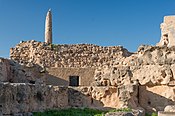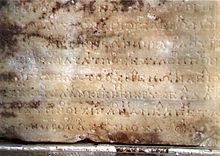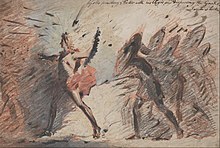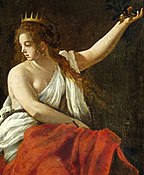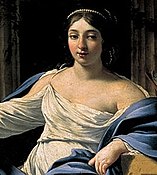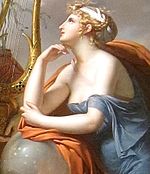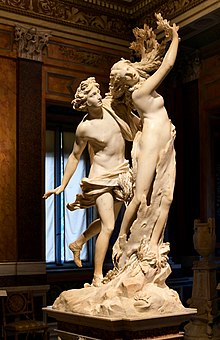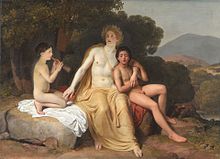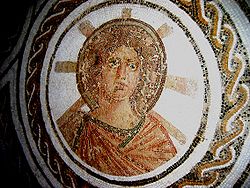Apollo
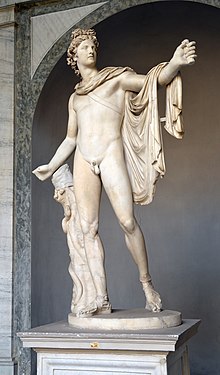
Apollo (Greek: Ἀπόλλων, transl. Apóllōn, or Ἀπέλλων, transl. Apellōn) is one of the main deities of the Greek mythology, and one of the most significant Olympic gods, which is why a large number of temples were dedicated to him. The son of Zeus and Leto, and twin of Artemis, he possessed many attributes and functions, and was possibly the most influential and revered male god of all classical antiquity after Zeus.
He is described as the god of the arts, of the bow and arrow, who threatened or protected from the heights of the heavens, being identified with the light of truth. He was feared by the other gods and only his father and his mother could contain him. He is the god of sudden death, plagues and diseases, but also the god of healing and protection against evil forces. In addition, he is the god of beauty, perfection, harmony, balance and reason, the initiator of youth in the world of adults, he was connected to nature, herbs and herds, and He is protector of shepherds, sailors and archers.
The origins of his myth are obscure, but in the time of Homer (8th century BC) It was of great importance, being one of the most cited in the Iliad. Later Roman mythology includes it in the V century BC. C., time in which the first temple is dedicated to him.
He made people aware of their sins and was the agent of their purification; he presided over the laws of religion and the constitutions of the cities.
He was a symbol of prophetic and artistic inspiration, being the patron of the most famous oracle of antiquity, the oracle of Delphi, and leader of the muses. As head of the inspiring Muses (with the epithet Apollo Musageta ), and director of their choir, he acted as patron god of music and poetry. The lyre from him became a common attribute. The hymns sung in his honor were called paeans (Paean was his grandson, son of Asclepius).
He had many love affairs, especially with his muses, and as a result of his adventures he had around twenty children, although in that area he had some misfortunes. In addition, he had a series of male lovers, including Cyparissus and Hyacinthus. He was depicted countless times since antiquity, usually as a naked, beardless young man, in the prime of his vigour, sometimes wearing a cloak, a bow and a quiver of arrows, and usually a lyre, created for him by his brother Hermes, and with some of his symbolic animals such as the snake (used in medicine), the raven or the griffin.
In Hellenistic times, especially during the III century B.C. C., went from the epithet Apollo Helios to be identified by the Greeks with Helios, god of the sun, and in a similar way his sister was equated with Selene, goddess of the moon.
Currently, and after a prolonged silence of centuries, his cult is carried out by the followers of Hellenism from Europe and America, especially from Greece.
His myth has been used for centuries by philosophers, artists and other intellectuals for the interpretation and illustration of a variety of aspects of human life, society and natural phenomena, and his image is present in a great variety of forms in our days.
Etymology
It was called by the Greeks «Apollon» or «Apellon», by the Romans «Apollo» and by the Etruscans «Apulu» or «Aplu». The origin of the name Apollo is uncertain. Ancient authors collected several examples of folk etymology. Thus, Plato relates the name in his Cratylus to ἀπόλυσις, 'to redeem', to ἀπόλουσις, 'purification', to ἁπλοῦν, 'simple', in particular in reference to the Thessalian form of the name, Ἄπλουν, and finally with Ἀει-βάλλων, 'the one who always shoots'. Hesiquio relates the name «Apollo» with the Doric απελλα apella, which means 'assembly', so that Apollo would be the god of political life, and also gives the explanation σηκος, 'flock', in which case Apollo would be the god of flocks and herds.
For Plotinus, his name means the denial of plurality: "not many", and he added that for the Pythagoreans it meant the One. Plutarch, following this line, affirmed that the Pythagoreans associated divine names to numbers, and that the monad was identified with Apollo. Burkert suggested that it derives from "holy convocation," which Nagy considers plausible, based on what Hesychius of Alexandria also stated, but this etymology has been rejected by Frisk, Chantraine and Dietrich, who consider the origin of the name to be simply unknown. Bernal hypothesizes that it derives from Horus, the Egyptian sky god, through intermediate phonetic adaptations in Phoenicia. Herodotus said that Apollo and Horus were the same god.
It is also possible that apellai derives from an ancient form of Apollo that can be equated with Apaliunas, an Anatolian god whose name possibly means 'father lion' or 'father light'. The Greeks later associated the name Apollo with the verb απολλυμι apollymi , 'to destroy', for which reason he was seen among them as & # 34;he who totally destroys & # 34;; This is how he presents himself to the god at the beginning of the Iliad , causing sickness and death among the Achaeans by means of his arrows, and for this reason receiving the name "he who wounds from afar" & # 3. 4;.
In addition, it has been suggested that Apollo derives from the Hurrian and Hittite deity Aplu, who was widely invoked during plague years. Aplu, it is suggested, comes from the Akkadian Aplu Enlil, meaning 'the son of Enlil', a title applied to the god Nergal, who was related to Shamash, the Babylonian sun god.
Origins of the cult of Apollo
It seems that both the Greek and Etruscan Apollos reached the Aegean Sea during the Iron Age (ca. 1100 - 800 BC) from Anatolia. In the Iliad, Apollo is on the Trojan side, against the Achaeans, in the Trojan War. In the Early Bronze Age (1700 to 1200 BC), the Hittite and Hurrian Aplu, like Homeric Apollo, was a god of plagues and resembled the mouse god Apollo Smintheus.
There is an apotropaic situation here, in which a god who originally brought the plague was invoked to end it, blending over time by fusion with the Mycenaean healing god Pean (PA-JA-WO in Linear B), who in Homer's Iliad he was an independent deity, the healer of the wounds of Ares and Hades, In other authors the word became a mere epithet of Apollo in this facet of god of healing.
Homer illustrated both the god Paean and the song as either apotropaic thanksgiving or triumph, and Hesiod also separated the two. In later poetry, Paean is invoked independently as the god of healing. It is equally difficult to separate Peán in the sense of 'healer' from Peán in the sense of 'song'.
Such songs were originally addressed to Apollo and later to other gods (such as Dionysus, Helios and Asclepius) related to him. About the IV century BC. C. the paean became a simple flattery formula, whose purpose was to implore protection against disease and misfortune or to give thanks after achieving said protection.
In this way Apollo became recognized as the god of music. His role as slayer of Python led to his association with battle and victory, hence the Roman custom for armies to sing a paean when marching and before going into battle, when a fleet was leaving port, and also after achieving a victory. victory.
Apollo's links with oracles also seem to be related to the desire to know the outcome of a disease. He is the god of music and the lyre. Healing belongs to his realm: he was the father of Asclepius, the god of medicine. The Muses were part of his entourage, so music, history, poetry, and dance belonged to him.
Places of worship
Unusual among Olympian deities, Apollo had two places of worship with widespread influence: Delos and Delphi. The cults of Cynthian Apollo and Pythian Apollo were so different that they may have sanctuaries in the same locality. That apellai derives from an ancient form of Apollo that can be equated with Apaliunas, an Anatolian god whose name possibly means 'father lion' or 'father light'. The Greeks later associated the name Apollo with the verb απολλυμι apollymi, 'to destroy'. Theophoric names such as "Apoldorus" or "Apollonius" and cities named Apollonia appear throughout the Greek world. The cult of Apollo was already fully established when the written sources began, around 650 BC. c.
Oracular Shrines
Apollo had his most popular oracle in Delphi, whose construction was an authentic acropolis protected by walls, with fountains, a theater and large individual chambers divided by cities of origin, where the consultants left their offerings (mostly carved in gold, bronze, and precious stones). This temple received thousands of visitors from all over Greece and the Mediterranean world, and Alexander the Great was one of its most illustrious visitors. Here the fortune teller predicted that he would "conquer the world". This oracle had the peculiarity of not failing with predictions.
Also other notable temples in Claros and Bránquidas. His oracular altar in Abas (Phocida), from which comes the toponymic epithet Abeo (Ἀβαῖος: Abaios ), was important enough to be consulted by Croesus.
Among their oracular shrines were:
- In Didima, an oracle on the coast of Anatolia, southwest of Sardes (Lidia), in which the priests of the lineage of the bronchies received their inspiration by drinking from a healing spring located in the temple.
- In Hierapolis Bambyce (Asia Menor), according to the treaty Dea Syria, the sanctuary of the Syrian goddess contained an image of Apollo with tunic and beard. The divinations were made from the spontaneous movements of this image.
- In Delos there was an oracle of Apollo Delio during the summer. The Hieron (‘sanctuary’) of Apollo adjacent to the Sacred Lake was the place where the god was believed to be born.
- In Corinth, the oracle came from the city of Tenea, of prisoners allegedly captured in the Trojan War.
- In Abas (Fócida).
- In the Temple of Apollo in Delfos, the Pitia was filled with the pneuma (πνευμα) of Apollo, which was said to come from a spring within the adyton.
- In Patara (Licia) there was an oracle of Apollo in winter, of which it was said that it was the place where the god went from Delos. As in Delfos, Patara's oracle was a woman.
- In Claros, on the west coast of Asia Minor, as in Delfos a sacred source gave a pneuma of the priests.
- In Segesta, Sicilia.
Other temples of Apollo
- In Thebes, the oldest temple, 9th century B.C. probably dedicated to Apollo Ismenio. Looks like it was a curved building. At the beginning of the 7th century B.C., a doric temple was built from which only small parts have been recovered. There were the Dafneforias fiestas celebrated every nine years in honor of Apollo Ismenio (or Galaxio). Participants had laurel branches (dafnai), and at the head of the procession, a young man (elected priest of Apollo), who was called "dafnéforo".
- In Rome there was a Apollo temple dedicated to Apollo Medicus, probably next to the temple of the goddess of the Belone war.
- Temple of Apollo Act of the CenturyVa. C., in the Promontory of Actium, on the coast of Acarnania.
- Apollo Temple in Termon, Etolia.
- Temple of Apollo Agieo (‘protector of the streets’) in the city of Megalopolis, in Arcadia.
- Apollo Temple in Apollo (Epiro).
- Temple of Apollo on the island of Ortigia, in Syracuse (Sicilia).
- Apollo Temple in Figalia, in Arcadia.
- Apollo Temple in Corinth.
- Apollo Temple in Delos.
- Delfinio Apollo Temple in Dreros, northeast of Crete (sixteenth centuryVIIIa. C.)
- Temple of Apollo in Utica, north of Tunisia.
- Apolo Temple Gallery
Festivals
The main festivals celebrated in honor of Apollo were the
- Boedromias
- Carneas
- Carpesses
- Dafneforias
- Delias
- Jacintia
- Metageitnias
- Pianepsies
- Pitias
- Targelias.
Attributes and symbols
Apollo's most common attributes were the bow and arrow. His attributes also included the zither (an advanced version of the lyre), the plectrum, and the sword. Another common emblem was the sacrificial tripod, representative of his prophetic powers. The laurel was used in expiatory sacrifices and also to make the crown of victory in the Pythian Games, which were held in his honor every four years in Delphi. The palm tree was also sacred to him because he had been born under one of them in Delos. Animals sacred to him included wolves, dolphins and roe deer, whooper swan and cicadas (symbolizing music), hawks, the gray crow, ravens and snakes (alluding to his functions as god of music). prophecy), mice and griffins, mythical eagle-lion hybrids of oriental origin.
As the god of colonization, Apollo advised on colonies, especially during the heyday of 750 to 550 B.C. C. According to Greek tradition, he helped the Cretan or Arcadian colonists to found the city of Troy. However, this story could reflect a cultural influence running in the opposite direction: Hittite cuneiform texts mention an Asia Minor god named Appaliunas or Apalunas in connection with the city of Wilusa mentioned in Hittite inscriptions, now considered identical to Greek Ilion by most researchers. In this interpretation, the title Lykegenes can be read simply as 'born in Lycia', effectively cutting off the god's supposed link to wolves (possibly a folk etymology).
In the literary context, Apollo represents harmony, order and reason, characteristics that contrasted with those of Dionysus, god of wine, who represented ecstasy and disorder. The contrast between the roles of these gods is reflected in the adjectives Apollonian and Dionysian. However, the Greeks thought of the two qualities as complementary: the two gods are brothers, and when Apollo left for Hyperborea in the winter he left the oracle of Delphi to Dionysus. This contrast seems to be shown on the sides of the Borghese vase.
Apollo is frequently associated with the golden mean, this being the Greek ideal of moderation and a virtue opposed to gluttony.
Influence of Apollo on the art of Greece
The cult of Apollo as patron of the Arts, and the respective cult of the muses, was of vital importance in Ancient Greece, and to whom they owed the progressive development in all artistic branches (which are the foundations of the current ongoing), such as theatre, music, dance, poetry, painting. The Greeks considered music very important in their lives, for this reason it is possible to see representations of people playing their instruments in vases and paintings. For the first time the theories of music were developed in the s. VII a. C., from the studies of Pythagoras, establishing the seven notes, the study of scales, concepts of perfect fifth and eighths, and the trilogies I-IV-V (fundamentals used in the various current musical genres). Meanwhile the theater established the genres of drama, comedy and tragedy. Theater building flourished throughout Hellas.
In art Apollo is depicted as a handsome, beardless young man, often holding a zither (as Apollo Citaredo) or a bow in hand, or reclining on a tree (the Lycian Apollo and Saurochthonous Apollo types). The Apollo Belvedere is a marble sculpture that was rediscovered at the end of the XV century and that from the Renaissance to the XIX has epitomized the ideals of classical antiquity for Europeans. It is a Hellenistic or Roman copy of a bronze original by the Greek sculptor Leochares made between 350 and 325 B.C. c.
On the late-century Roman floor mosaic II of El Djem (the Roman Tisdro) he can be identified as Apollo Helios for his radiant halo, though then even a god's divine nakedness is hidden beneath his robes, a sign of increasing conventions of modesty in the late Empire. Another mosaic of Apollo with halo, from Hadrumento, is in the Archaeological Museum of Susa. The conventions of this depiction—head turned to one side, lips slightly parted, large eyes, anastolean haircut - in curls falling to the neck—developed in the III century BC. C. to represent Alexander the Great. Centuries later the representations of Christ and Christian saints would be identical to archaeological remains found, in which Apollo is distinguished surrounded by halos of light or solar flashes, as in a mosaic found in Carthage.
In the Cretan city of Dreros, a statuette of Apollo made in the early orientalizing style of the turn of the century was found VIII a. C. (or around 650 BC), using the sphyrelaton technique, that is, hammering sheets of bronze on a wooden core that gave them shape. It is 80 cm and has very marked pectorals. It is currently in the Archaeological Museum of Heraklion.
Other notable ancient representations are the Apollo of Piombino and the Great Golden Apollo of Lillebonne, both preserved in the Louvre Museum.
Mythology
The first literary references to Apollo are found in Homer, at the very foundation of Greek literature. Apollo is mentioned in the Odyssey and is one of the main gods of the Iliad. As is evident, despite the uncertainty about the origin of the myth and the absence of earlier documentation, in the 8th century a. C. was already consolidated. At the time of the formation of the Homeric hymns , the god already appeared so loaded with attributes that the poet found it difficult to choose where to begin his praise.
How should I sing to you, celebrated as you are for all kinds of hymns?Homerical hymn III, Apollo, 19.
Birth
When Hera learned that Leto was pregnant and that Zeus was the father, she forbade her to give birth on mainland, or the mainland, or any island in the sea. In her wandering, Leto found the newly created floating island of Delos, which was neither the mainland nor an actual island, and gave birth there. The island was surrounded by swans. Afterward, Zeus secured Delos to the bottom of the ocean. Later this island was consecrated to Apollo.
It is also claimed that Hera kidnapped Illithia, the goddess of childbirth, to prevent Leto from giving birth. The other gods tricked Hera into letting her go by offering her an eight meter long amber necklace. Mythographers agree that Artemis was born first and that she helped Apollo to be born, or that Artemis was born the day before Apollo, on the island of Ortygia, and that she helped Leto cross the sea to Delos the next day to give birth. to Apollo. Apollo was born on the seventh day (ἡβδομαγενης) of Targelion, according to Delian tradition or in the month of Bysio according to Delphic tradition. The days 7 and 20, new and full moons, have been dedicated to him ever since.
Origin of the myth of the lyre
Hermes was born on Mount Cylene in Arcadia. This story is told in the Homeric hymn to Hermes, as it is known, he is the god of business, voyages, and thieves. His mother, Maia, had become pregnant from an affair with Zeus. Maia put the infant Hermes to sleep, and he escaped while she was sleeping. He ran to Thessaly, where Apollo was herding his cattle. In an oversight, the infant Hermes stole several of his cows and took them to a cave in the woods near Pylos, covering their tracks. In the cave he found a turtle, killed it and hollowed out the shell, taking out the entrails. He used the intestines of one of the cows and the shell of the turtle to make the first lyre. Apollo complained to Maia that her son had stolen her cattle, but Hermes had already returned to the blankets she had left him in posing as asleep, so Maia refused to believe Apollo's claims. Zeus intervened and, claiming to have seen the facts, seconded Apollo. Then Hermes began to play music on the lyre that he had invented. Apollo, a god of music, fell in love with the instrument and offered to allow the exchange of cattle for the lyre. Thus, Apollo became a master of the lyre.
Origin of the myth of Delphi
Four days after his birth, Apollo slew the chthonic dragon Python, who lived in Delphi near the Castalia spring. This source was the one that emitted the vapors that caused the oracle of Delphi to make his prophecies. Hera sent the serpent to chase and kill Leto across the world. To protect his mother from him, Apollo begged Hephaestus for a bow and arrow. Upon receiving them, Apollo cornered Python in the sacred cave at Delphi. Apollo killed Python but was punished for it, as Python was a son of Gaia.
Hera then sent the giant Titius to kill Leto. This time Apollo was helped by his sister Artemis in protecting his mother. During the battle Zeus finally relinquished his help and threw Ticio into Tartarus. There he was fastened to the rocky soil, covering nine acres, and a pair of vultures ate his liver daily.
Musical duels
- On one occasion Pan had the audacity to compare his music with that of Apollo, and to challenge this, the god of the cult, to a test of skill. Tmolo, the mountain god, was elected referee. Pan blew his flautas, and with his rustic melody gave great satisfaction to himself and only to his fervent follower, King Midas who was present. Then Apollo polished his lira strings. Tmolo immediately declared victor to Apollo, and all (except Midas) agreed. He dissented, and questioned the justice of the judgment. Apollo didn't want to suffer so depraved a couple of ears again, and made his ears turn into donkey ears.
- Marsias was a sadist who challenged Apollo to a music contest. He had found an aulos (two tube flute) on the ground, which had thrown the goddess Athena after inventing it because it made his cheeks swell. The contest was judged by the Muses. After each one touched, they were both considered equal, until Apollo decreed that he stumbled and sang at the same time. As he touched the lira, he could do it, but the aulos is a wind instrument. Marsias was defeated, so Apollo was declared a victor. Apollo desolated Marsias alive in a cave near Calaenae in Frigia for his hybrids (unmeasured pride) by challenging a god. His shed blood became the Marsian River. Another version is that Apollo touched his instrument of the reverse, which Marsias could not do, so Apollo hung it from a tree and skinned it alive.
- Apollo also competed in a lira contest with Cíniras, his son, who committed suicide after losing.
The Trojan War
Although at first, their father Zeus asked his god sons not to intervene in the Trojan War, they finally ended up participating, divided on both sides. Apollo and Aphrodite convinced Ares to fight on the Trojan side, since two of Apollo's sons were on the Trojan side, Hector and Troilus.
In the Iliad, Apollo interfered at Agamemnon's insult to Chryses, one of his priests, whose daughter Chryseis had been kidnapped. Chryses was urged to withdraw away from the Achaeans, who in their lonely retreat from him, in tears implored the god Apollo in the face of such injustice, to which Apollo flooded the Achaean camp with infected arrows, and demanded his release. The Achaeans ended up giving in, indirectly provoking the fury of Achilles.
Apollo helped Paris kill Achilles by guiding the arrow from his bow to Achilles' heel, in revenge for Achilles' sacrilege in killing Troilus and Hector, sons of Apollo.
The Muses of Apollo
In Greek mythology, the muses (in ancient Greek μοῦσαι «mousai») are the inspiring divinities of the Arts, and each of them is related to artistic branches and knowledge. Daughters of Zeus, companions of the entourage of Apollo, god of music and patron of the fine arts, who had romances with each of them, leaving descendants. They came down to earth to whisper ideas and inspire those mortals who invoked them. Around the VIII-VII centuries BC. C. prevailed throughout the territory of Hellas the worship of the nine Muses, which are Calliope, Clio, Erato, Euterpe, Melpomene, Polyhymnia, Thalia, Terpsichore and Urania. From the word muse comes the word music. They were of vital importance for artistic development in Ancient Greece.
- The nine Musas
Lovers, consorts and offspring
According to classical sources, Pausanias, Apollonius of Rhodes, Pindar and Pliny the Elder, Apollo, the eternal beardless kuros, had at least a hundred children, the product of his innumerable love affairs, there are at least three counted. digits of female lovers, whose descendants include Orpheus (citaredo hero), Asclepius (revered as one of the most important icons of classical medicine), Aristeo (he was the rustic god of beekeeping) and a whole long series, several have given names to cities, or kings. Some of his colleagues have been:
Consorts and offspring
| Lover | Prole de Apolo |
|---|---|
| Achalalide | Apollo also did not overlook Acacálide or Acalis, Hermes's lover. Each version makes it the mother of a different child by Apollo: Anfítemis or Garamante, Mileto, Naxo, Oaxes, Filácides or Filandro. |
| Agatipe | Chrysoros. The ancient name of the river Compact and its name comes from the son of Apollo and Agatipe (Aganipe), who dared to steal the treasure of Creso and in the end had no choice but to throw himself into the river. |
| Alcíope | In some versions, the name of Lino's mother. |
| Anquire | According to Servio Anquíale was the mother of Oaxes. |
| Aria | Mileto. When Minos, Radamantis and Sarpedon grew up they fought for the love of a boy named Mileto, the son of Apollo and Aria, the daughter of Cléoco. |
| Arsínoe | Arsinoe, by Febo domeñada, gave birth in palace to Asclepio, leader of men, and to Eriópide or Eriopis of beautiful loops. Arsínoe preferred Isquis and cohabited with him. |
| Astícoma | In a rare version Eumolpo is the son of Apollo and the ninpha Astícoma. |
| Astreide | It is said that Febo Apollo on the skirts of the Parneto played with the Ninpha Astreide or Astreis, who was the daughter of Yaso and granddaughter of Eleuter. |
| Babilonide | The Greeks imagined an eponymous nymph of Babylon, called Babilonide, Babilonis or Bábilo, who joined Apollo was the mother of Arabbo according to a version. |
| Caliceope | From Caliope and Eagro, or supposedly Apollo, Lino was born, who killed Heracles, and Orpheus, the citeredo, who with his singing moved the stones and the trees. |
| Celeno or Tuya
or Melena | The eponymous Delfo is the son of Apollo in three different versions offered by the same source. His mother is Celeno, the daughter of Híamo, or Tuya, the daughter of Castalius, or Melena, the daughter of Cefiso. |
| Cirene | Apollo was also invaded by the love of Cyrene, the daughter of Peneo, and of both Aristeus was born. Another dark version says that from that union a certain Autuquium was also born. In his FablesHigino appoints the two possible parents of Idmon (Apollo and Abante) and indicates, in the case that he is the son of Apollo, that his mother is the Ninpha Cyrene. |
| Coricia | It is reported that Apollo had a son of the Ninpha Coricia called Licoro, and by Licoro was called the city Licorea, and by the nymph, the cave Coricia. |
| Corónide or Coronis | From Apollo and Corónide was born Asclepio, who learned from his father many precepts of the art of medicine. Flegias was furious after the death of his daughter and burned Apollo's temple in Delfos, so Apollo killed him. |
| Creussa | In the work of Eurípides entitled IonApollo breeds Ion in Creussa, who is Juto's wife. Creussa leaves Ion in the woods, but Apollo asks Hermes to save the child and take him to the Oracle of Delphis; so does Hermes, and the child is raised by a priestess. As Juto was barren he accepted Ion as his own son. |
| Crisorte | In the line of succession of the kings of Sition it is said that Orthopolis had a daughter, Crisorte; they believe that this gave birth to Apollo a son called Coronus, and of Coronus were born Corax and another younger, Lamedonte. |
| Crisótemis | Esfilo's wife is said to give birth to Partenos united to Apollo. |
| Danaide | Danaide or Danais, Crete's nymph, is the mother, by Apollo, of the healers in a version. |
| Day | Day is the daughter of King Lycaon and mother of Triop by Apollo. |
| Dríope | Apollo then joined Dríope in the form of a snake. This, terrified, ran to his father's house, although he told nothing of what happened to his family. Later, Andremon, son of Oxyl, married her and Dríope gave birth to a son, Anphisus, the fruit of his union with Apollo. Anfiso was the founder of Amphisa. |
| Epicasta | Trofonius was the son of Ergino, king of the minias of Orcomeno and brother of Agamedes. It is said that Apollo loved Trofonio's mother, Epicasta. |
| Stilbe | Estilbe, the daughter of Peneo and Creussa, gave Apollo two twin sons, Centaur, ancestor of the centurs, and Lapito, an ancestor of the lapitas. It is also said that Eneo, the father of Cícico, was the son of Apollo and Estilbe. |
| Etusa | Poseidon then joined with the pleiade Alcíone, with whom he had two sons, Hirieo and Hiperénor, and a daughter, Etusa, the mother of Eleuter by Apollo. |
| Eubea | Apollo was invaded by the desire of Eubea, the daughter of Macareo, and with her he begat Arigoo or Agreo; having sex with her gave her name to the island. |
| Evadne | Apollo made Evedne, the daughter of Poseidon, the mother of Yamo or Iamo, the eponymous of the yamids. During the birth Apollo sent Ilitia, the goddess of the light, to assist her. |
| Philoid or Filonis | The divine Philoid gave light to Autholic and Phillamon famous for his voice, to this domeñada by Apollo that hurts from afar. |
| Ftía | The daughter of Foroneo was seduced by Apollo in the form of a dove. Etolo killed Apis, the son of Foroneo, and fled to the country of the healers; there he killed his guests Doro, Laodoco and Polipetes, the sons of Ftía and Apollo. |
| Hécale o Hécuba | At least Íbico, Alejandro, Euforion and Licofron agree that Hector is the natural son of Apollo and not of Pyriamus. It is also said that it is said that Troilo was begotten by Apollo. |
| Hide or Silis | Festus, king of Sition, moved by virtue of an oracle to Crete. It happened to him in the government, King Zeuxipo, son of Apollo and Ninpha Hide. |
| Hipermestra | Anfiarao is the son of Oícles, or Apollo as other authors say, and of Hipermestra, the daughter of Testio. Anfiarao marched against Thebes. |
| Manto | Mopso is the son of Mantus, daughter of the famous prophet Tiresiah; at least in a version we are told that Apollo was his true father. |
| Melia | They say Apollo had two sons of the Oceanide Melia: Tanero and Ismeno. Athenero gave Apollo the art of divination, and the river took the name of Ismeno. |
| Otreide | Only quoted by Antonino Liberal, is the mother of Fagro by Apollo and Meliteo by Zeus. |
| Parténope | From Anceo and Samia, daughter of Meandro, sons and Parthenope were born. From Partenope and Apollo, Licomedes was born. |
| Proclea | Tenes, the son of Cynicus and Proclea, or Apollo, reigned in Ténedos, according to others. I was there because I was banished by his father. |
| Pronoe | Prónoe is a venerable nymph of Mount Eta who joined Apollo in the mountains and, behold, he gave birth to Melaneo. Apollo kidnapped Estratonice and gave it to Melaneo as a wife; they were the fathers of Éurito, king of Ecalia. |
| Take it easy. | They say that in the time of the reign of Crótopo in Argos, Psámate, his daughter, gave birth to a son of Apollo called Lino, but dominated by the fear of Chrotopo explained Lino and Apollo punished Argos by sending the monstrous Poine (Pena), who snatched the children from their mothers. |
| Quíone or Leuconoe | The mother of Filamon in the Roman sources. I hate it as Quíone, daughter of Dedalion. When his daughter died, Dedalion threw himself desperate from Mount Parnaso, but Apollo avoided his death by transforming him into a gavilan. Higino calls it Leucone or Leuconoe. |
| Reo | Reo was the daughter of Esfilo and therefore the granddaughter of Dioniso and Ariadna. Apollo had an affair with Reo and she gave birth to Anio, for the pain that caused him in the light. Anio was king of Delos and priest of Apollo. |
| Rodesia | By Apollo it was Ceo's mother, the eponymous of the island of Ceos. |
| Ródope | By Apollo was the mother of Cycon, the eponymous of the cicons. |
| Synopsis | Sinope, one of the daughters of Asopo, was kidnapped by Apollo and taken to the place where the city is currently named after Sinope. From her and Apollo was born a son, Siro or Sirio, who was king of those who received the name of Syrians by him. |
| Talia or Retia | Talia and Apollo were born. Ferécides refers on the one hand to nine cirbants (coribantes), who would be children of Apollo and Retia and who would have settled in Samotracia. |
| Temisto | Temisto, daughter of the hyperbore king Zabio and mother of Galeo by Apollo. |
| Iron | The present name of Cheronea came to him from Chiron, for they say that he is the son of Apollo, and his mother was Tero, the daughter of Philante. |
| Tiria or Hiria | Cynicus, son of Apollo and Tiria, who put several tests on his lover Philius; finally Apollo metamorphosed him, along with his mother, in swans. |
| Urania | Apollo and the muse Urania were parents of Lino, the famous aedo. |
| Urea | The name of Ureaa daughter of Poseidon remains corrupt in the text. From Urea And Apollo is Ileo son. This Ileum is identified with Oileo, the father of Ayax; and the unnamed mother of Ileo was one of the nymphs. |
| Zeuxipe | Ptoo, an eponymous of Mount Ptoo de Beocia, was the son, among other versions, of Apollo and Zeuxipe, the daughter of Atamante. |
Sons of Apollo by unknown mothers
- Acrepheus. The eponymous hero of the city Acrefias de Beocia, near Lake Copaide.
- Apis de Argos, a land also called Apia. He has taken that name from antiquity in honor of a healer. For Apis, seer and healer, son of Apollo, came from Naupacto, on the farthest shore and purified this land of mortal monsters for man, that the earth vomited contaminated.
- Cariclo, Quirón's wife, is Apollo's daughter among two other affiliations.
- Cyniras, the chief king, was the son of Apollo according to Hesichius.
- Epidauro, the eponymous hero, is the son of Apollo according to the epidaurians themselves.
- Erimanto saw Aphrodite bathing naked after adonis and was blinded by the wrath of the goddess. Apollo sold himself from Aphrodite transforming into wild boar to kill Adonis.
- Femonoe was the first pitia of Apollo and would have invented the hexameter verse as a vehicle of his prophecies. It is also due to her the famous "convite yourself".
- Marato or Marathon is the eponymous hero of Marathon.
- Megaro or Megareo, the eponymous of Megara, is the divine son of Apollo or Aegean.
- Mélite, quoted as daughter of Apollo or Mirmex, is the eponymous of Melite's demo in the Atica. Some say this Mélite was a lover of Heracles.
- Onco is the son of Apollo according to fame, and in the Telpusa region he reigned in the place of Once, where Deméter was known as an Erinis.
- Flat was the eponymous founder of Pisa in Etruria, according to Roman authors.
- Pitaeo. The name of Pitaeo has learned it from the argivos, for Telesila says that these were the first Greeks to whose region Pitaeo arrived, who was the son of Apollo.
- The muses topoloidsFor they are three daughters of Apollo: they are called Apolonis (or Apolónide), Borístenis (or Boristénide) and Cefiso.
Other female loves and heartbreaks (without offspring)
- Bolina, a maid of Achaia, was admired by Apollo but she rejected him, kneeling to the sea. To prevent his death Apollo thus turned her into a nymph, saving her life.
- Casandra, from whom Apollo fell in love too. Hija de Hecuba y Príamo, and Troilo's step-sister. Apollo promised Casandra the gift of prophecy only to seduce her, but she learned of God's impure intentions, rejected her. Enraged, Apollo instead of taking away the gift, granted him the curse that no one ever believed his predictions, so predicted the fall of Troy.
- Castalia was a nymph whom Apollo loved. Castalia fled from him and plunged into the fountain at Delfos at the foot of Mount Parnaso, which has since been called Castalia's source. The water of this source was sacred: it was used to clean the temples of Delphi and also inspired the poets.
- Dafne. To explain Apolo's relationship with Dafne, the laurel tree whose leaves used his priestesses in Delfos, was collected by Libanio, professor and returnr of the centuryIVthat Apollo persecuted a nymph who had betrayed him: Dafne, the daughter of Peneo. In Ovid's account for the Roman public, Apollo Febo mocks Cupid for playing with a man's own weapon, which causes him to smite with a golden arrow; simultaneously, however, he had shot a lead arrow at Dafne, causing him to feel repulsion to Apollo. After a foggy persecution, Dafne prayed to Mother Earth—or alternatively to her father, a river god— asking for help, and this transformed her into a laurel tree, consecrated to Apollo.
- Marpesa was kidnapped by Idas but also loved by Apollo. Zeus made him choose between the two, and Marpesa chose Idas reasoning that Apollo, being immortal, would end up getting tired of her when she was old.
- Ocírroe, a daughter of Imbraso, who tried to flee from Apollo but this turned into stone the ship he fled and his driver into a pilot fish.
- Sinope, once a nymph, who mocked Zeus' ardent courtesies, impassible to heavenly suitors; neither Halis nor Apollo were deceived by the stunts of the nymph they loved.
Male lovers
- I promise. Apollo as Nomio from the banks of the Anfriso cared for the firing mares, burning with desire for young Admeto.
- Adonis. According to a version Adonis was a lover of both Apollo and Afrodita. He behaved as a man with Aphrodite and as a woman with Apollo.
- Atimnio. In a single variant the cretense Atimnio is Apollo's lover. In the rest of the sources Atimnio was loved by Sarpedón, not Apollo.
- Bóreas. Zetes asks the identity of Fineo, "Faith's friend, loved by our father."
- Branco. Apollo kissed him and Branco, having received prophetic skills from his lover, introduced the worship of the god in Didima.
- Cyncles. The voices of the cyniras resonate in loanzas multiple times: Apollo, the golden ghettos, loved him kindly, sweet priest of Aphrodite.
- Cipariso. In a late version Cipariso is a descendant of Heracles. Apollo gave him a beautiful domesticated deer as a partner, but Cipariso accidentally killed him with a pilum when he lay asleep between the weed. Cipariso then asked Apollo to make her tears rodaen forever. Apollo agreed to the request by transforming him into a cypress, which is said to be a tree representative of sadness because his sap forms drops that resemble tears in the trunk.
- Forbante. The son of Triopas and Hiscila, considered a serpent-killing hero. The ancient poets tell the stories of love that Apollo had with Forbante.
- Héleno. It is said that this Apollo lover received from the god a ivory arch with which he later wounded Achilles in his hand.
- Himeneus. This is the son of the eponymous Magnes, in turn the son of Argos and the grandson of Frixo. Himeneus was renowned for his beauty. Apollo saw him on one occasion, and fell in love with him, and did not leave the house of Magnes.
- Hippolyte. Native to Sition. Hippolyte, of whom it is said that, every time he went out to sail from Sition to Cirra, the priestess pitonisa, as if the god knew of his arrival and rejoiced for it, he intonated verses of rejoicing.
- Jacinto. Son of the Clío and Píero muse, he was a young Spartan prince under Apollo guardianship in the arts and athletics. While both practiced the release of the album, a album released by Apollo was diverted from his trajectory by Céfiro, hit Jacinto in the head and killed him instantly. When the young man died, Apollo felt so much pain that he turned Céfiro into wind so that no one could touch again or speak. From the blood of Jacinto, Apollo created the flower called him in tribute, his tears stained the petals with marks in the form of . ., which means ‘ay, ay!’, as a symbol of eternal regret. The Jacinto Festival (Jacintias) was a traditional celebration in Esparta.
Greek cult titles and epithets
Apollo, like other Greek deities, had a number of epithets applied to him to reflect the diversity of roles, gifts, and aspects ascribed to him. However, although he had a large number of names in Greek mythology, only a few appear in Latin literature. His epithets include:
- As a god of light and of the Sun:
- English (‘radiante’);
- Febo (‘brillante’), the most common in Latin literature;
- Liceo (¢Ü¢ειοςfor Apollo in the context of sun god or light.
- As a god of music:
- Citaredo
- As a god of medicine and healing:
- Acestor (Y: ¢Ü ¢Ü ¢Ü ¢Ü
- Acesio (Yea, sanεσιος, ’healer’), under which he was worshipped in Elis, where he had a temple in the agora;
- Agieo (;γυιες) as a protector of roads and homes;
- Alexicaco (,λείκακος, ‘the one who turns away disgrace’);
- Apotropeo (‘He who turns away evil’);
- Averruncus (‘departing evils’), Latin epithet;
- Iatros (Heare, ‘medical’);
- Medicus (‘medical’), Latin epithet; in Rome there was a temple dedicated to Apollo MedicusProbably next to Belona's.
- As god of pests and defender against rats and locusts:
- Culicarius (‘that separates the mosquitoes’), Latin epithet;
- Esminteo (σμινθειος, ‘catcher of mice’);
- Parnopio (καρνοπιος, ‘saltamontes’).
- As a god of the archery:
- Aphetoros (‘gods of the bow’);
- Argurotoxos ();ργυρότος, ‘of the silver bow’);
- Arcitenens (‘who carries the bow’), Roman epithet;
- Hekaergos (fitκάεργος, ‘who undoes away’), referring to their arrows;
- Hekebolos (blockκηβόλος, ‘he shoots far’).
- As a pastoral god of livestock:
- Lesson (#κιος, ‘wolves’) or Lykegenes (‘born of a wolf’);
- Nope (‘vagabundo’).
- As a god of settlers:
- Arcageta (Y: ¢Üχργετις, ‘director of the foundation’), for being founder of the walls of Megara;
- Clario (Κλαριος, of the doric κλαρος) klaros, ‘land allocation’), for its supervision over cities and colonies.
- As a god of the oracles:
- Cintiofrom his birth on Mount Cinto delos;
- Cirreoby Cirria, nearby town of Delfos;
- Clario (Κλαριος) for the sanctuary he had in Claros, Jonia (Colophon's Oracle);
- Delfinio (Δελφινιος, ‘from the uterus’), which associates Apollo with Delphoi (Delfos); an etiology in the homerical hymns associates this epithet with the dolphins;
- Lesson (#κιος, ‘de Licia’) or Lykegenes (‘born in Licia’), where some postulate the origin of their worship;
- Pitio (κυθιος, ‘pítico’), by κυθος PythoHomerical name of Delphi;
- Timbreo (urgeυμβριος) by the temple he had in Timbra.
- As a god of prophecy:
- Coelispex (‘watching the sky’), Roman epithet;
- Loxias (ο οf οf οf οf οf οf οf οf οf οf οf οf οf οf οf οf οf οf οf οf οf οf οf οf οf οf οf οf οf οf οf οf οf οf οf οf οf οf οf οf οf οf οf οf οf οf οf οf οf οf οf οf οf οf οf οf οf οf οf οf οf οf οf οf οf οf οf οf οf οf οf οf οf οf οf οf οf οf οf οf οf οf οf οf ο
- As head of muses and nymphs:
- Musageta (Mουσαγθτις, ‘jefe de las musas’);
- Ninfageta (‘Chief of Nymphas’);
- LesquenorioLatin leschisbecause he presided over the poetic and musical assemblies and the meetings of the muses.
- In relation to cities and regions:
- Abroad, epithet derived from the focide city of Abas, where the god had a sumptuous temple.
- Acrefio, epithet with which he was worshipped in the Beast of Acrefia, supposedly founded by his Acrepheus son;
- Actiaco, epithet given in the Actium, one of its main places of worship.
- In relation to characters:
- Ismeno (,σμιός, Ismēnios, literally, "of Ismeno") by Ismeno, son of Anfion and Níobe, who killed with an arrow.
- Others:
- Sayo, which means right, because a citizen who had hidden in the bosom of this god's statue in Thebes found some amount of money intact after the city was taken.
Worship in other regions
Roman cult
The Romans adopted the cult of Apollo from the Greeks with considerable posterity, absorbing the cultural influence of the Hellenic colonies, which were located to the south of the Italian peninsula (Magna Graecia), belatedly, building the first temple of Apollo in Rome in the V century BC. C., when the Hellenic cult had been going on for hundreds of years. As a genuinely Greek god, Apollo had no direct equivalent in Roman mythology, although later poets frequently referred to him as Phoebus.
There was a tradition that the Delphic oracle was consulted as early as the period of the Roman kings during the reign of Tarquin the Proud. On the occasion of a plague in 430 BC. The first temple was established in Rome on the Campos Flaminios, replacing an ancient place of worship known there as the Apollinare. During the Second Punic War, in 212 BC. C., the Ludi Apollinares ('Apollinian Games') were instituted in his honor, following the instructions of a prophecy attributed to a certain Marcio. In the time of Augustus, who considered himself under the special protection of Apollo, his cult developed and he became one of the main gods of Rome. After the Battle of Actium, which was fought near a sanctuary of Apollo, Augustus enlarged his ancient temple, dedicated a portion of the booty to him and instituted five-year games in his honour. He also had a new temple dedicated to Apollo erected on the Palatine Hill. The sacrifices and prayers on the Palatine dedicated to Apollo and Diana were the culmination of the secular games, held on the year 17 a. C. to commemorate the beginning of a new era.
Celtic worship
Apollo was worshiped throughout the Roman Empire. In traditionally Celtic lands he was commonly considered a healing and solar god. He was often equated with Celtic gods of similar characteristics.
Epithets and titles
- Apollo Atepomarus (‘great rider’ or ‘small horse’). Under this name Apollo was worshipped in Mauvrieres (Indre). In the Celtic world the horses were closely related to the sun.
- Apollo Belenus (‘brillante’). This epithet was given to Apollo in areas of Galia, northern Italy and Nórica (current Austria). Apollo Belenus was a solar god and healing.
- Apollo Cunomaglus (‘sir of hunting dogs’). Title given to Apollo at a Wiltshire altar. Apollo Cunomaglus may have been a god of healing. Cunomaglus himself may have originally been a god of healing other than Apollo.
- Apollo Grannuswhich was originally a spring god of healing, later equated with Apollo.
- Apollo Maponus. Known by inscriptions found in England, this god can be a local fusion of Apollo and Maponus.
- Apollo Moritasgus (‘masas of marine water’). Epithet given to Apollo in Alesia, where he was worshipped as a god of healing and possibly of doctors.
- Apollo Vindonnus (‘light clear’). He had a temple in Essarois, near Châtillon-sur-Seine (Borgoña). He was a god of healing, especially from the eyes.
- Apollo Virotutis (perhaps ‘benefactor of humanity’). He was worshipped, among other places, in Fins d'Annecy (Alta Saboya) and in Jublains (Maine and Loire).
Other myths
I admit
When Zeus struck down Apollo's son Asclepius with a thunderbolt for raising Hippolytus from the dead (thus transgressing Themis by stealing Hades's subjects), Apollo killed the Cyclopes, who had created the lightning bolt, in revenge. Zeus. Apollo was to have been banished to Tartarus forever, but he was instead sentenced to a year of forced labor as punishment, thanks to the intercession of his mother, Leto. During this time he worked as a shepherd for King Admetus of Feres in Thessaly. Admetus treated Apollo well, so in return he granted him great benefits.
Apollo helped Admetus win Alcestis, the daughter of King Pelias, and later convinced the Fates to allow Admetus to live longer than his fair share if someone else took his place. But when the time came for his death, his parents, whom he had assumed would be willing to die in his place, refused to cooperate. Instead, Alcestis took her place, but Heracles managed to "persuade" Thanatos, the god of death, to return her to the world of the living.
Niobe
Niobe, a queen of Thebes and wife of Amphion, boasted of her superiority over Leto because she had borne fourteen children (the Niobids), seven boys and seven girls, while Leto had only two. Apollo killed his sons while they were practicing athletics, despite his pleas, and Artemis his daughters. Apollo and Artemis used poisoned arrows to kill them, although according to some versions of the myth some of the Niobids (Niobe, later called Chloris) were spared. Amphion, seeing his sons killed by him, committed suicide or was killed by Apollo after swearing revenge. A desolate Niobe fled to Mount Sipylus in Asia Minor and was turned to stone as she wept. Her tears formed the river Aqueloo. Zeus had turned all the inhabitants of Thebes to stone, so no one buried the Niobids until the ninth day after their death, when the gods themselves buried them.
- Apollo gave Orestes, through the Oracle of Delphis, the order to kill his mother, Clitemnestra, and his lover, Egisto. Orestes was ferociously punished for this crime by the Eriniahs, who pursued him tirelessly until he asked for the intercession of Athena, who decreed that he was judged by a jury of his peers, with Apollo as a defender.
- In the OdysseyOdysseus and the rest of the surviving crew landed on an island consecrated to Helios, the sun god, who kept in it sacred cattle. Although Odysseus warned them not to do so (as Tiresias and Circe had told him), his men killed and ate part of the cattle, so Helios caused Zeus to destroy the ship and all his crew members except Odysseus..
Worship today
Her cult is preserved with the revival of Hellenism, a religious movement that evokes the religious practices and traditions of Ancient Greece.
Apollo in contemporary culture
Percy Bysshe Shelley composed a Hymn of Apollo (1820), and his instruction of the Muses was the subject of Stravinsky's Apollo Musageta (1927–1928).
The name Apollo remains current, often appearing in contemporary art, science and literature, where his name or image is represented in the names of people, companies, businesses, numerous and diverse artistic and literary fields, scientific projects, like NASA (Apollo project); theaters and cinemas with his name abound, especially in Spain, such as the Apolo in Madrid, Apolo in Murcia, Apolo in Barcelona, Apolo in Miranda de Ebros, rooms in Europe such as Opeth Apolo, Apolo movie theaters (Bosnia), Apolo Cinema (Tbilisi) the Münster cinema complex, parks and squares (Apolo de Vratislava, Apolo de Cartagena park), the Apolo Center, house of instruments and music academies (Apolo Música, Musical Apolo, Apolo Cítaras, in South America), the Hammersmith Apollo (London, England) rock bands (the Uruguayan Hijos de Apolo, and Apolo Rocks from Argentina), the Apolo choir from the city of Loretto in Italy, the list can be endless.
About the Large Hadron Collider (LHC), its location between Switzerland and France, there is a legend or conspiracy theory in which attention is drawn to its location in Saint-Genis- Pouilly, a French commune in the Rhone-Alpes region. Many point out that the chosen place is not accidental, because 'Pouilly' comes from the Latin 'Appolliacum' and it is believed that in Roman times there was a temple in honor of Apollo with a gateway to the underworld.
Fonts
- Mythological Library I, 3, 3.
- I, 3, 1 - 6: French text, with electronic index.
- I, 3, 3: English text, with electronic index, in the Perseus Project; ed. of 1921 by James Frazer at the Loeb Classical Library. At the top right are the active labels "focus"(to change the Greek text) and "load" (for the bilingual text).
- I, 3, 3: Greek text in Wikisource.
- I, 3, 3: English text, with electronic index, in the Perseus Project; ed. of 1921 by James Frazer at the Loeb Classical Library. At the top right are the active labels "focus"(to change the Greek text) and "load" (for the bilingual text).
- I, 3, 1 - 6: French text, with electronic index.
Contenido relacionado
Adventism
Salamanca School
Capitals sins



















